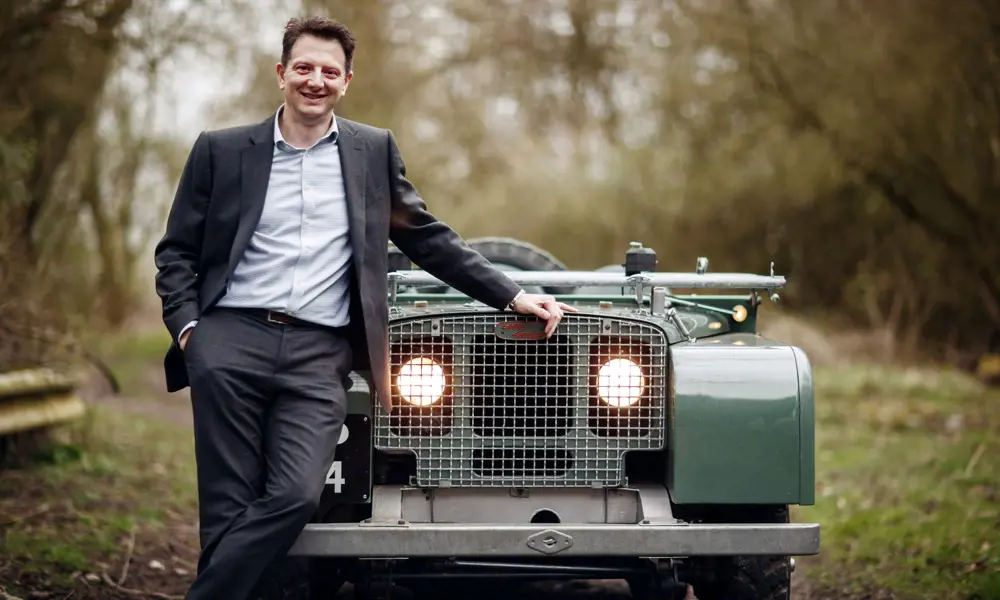
Driven to an electrifying future
Engineers at Jaguar Land Rover (JLR) will tell you that, thanks to concerns about climate change, air pollution and the rise of self-driving cars, the automotive industry will change more over the next five years than it did in the previous half century. Nick Rogers FREng sees these issues as opportunities for the 10,000 or so engineers that he leads as Executive Director of Product Engineering at JLR. Then again, Rogers has already seen plenty of change in his 35 years in the industry. When he started work as an apprentice technician at British Leyland’s (BL) Cowley works near Oxford, electronics was just beginning to make inroads into the car business.
Ironically, an electrical issue nearly killed Rogers’s career as a carmaker before it had started. A careers tutor at school encouraged Rogers to apply for a job at BL, where his grandfather had worked. Rogers’s experience maintaining tractors and mending other farm machinery at his family’s dairy farm had prepared him well for an apprenticeship. BL offered him a job as a technical apprentice but the obligatory medical test confirmed what Rogers had said all along: he was colour blind. He wanted to work as an electrical engineer but couldn’t tell the difference between the coloured wires. Rogers went home despondent and jobless, but this mood didn’t last long. The next morning, he was out on the farm when his father told him that BL wanted him to interview for body engineering. They offered him a job although he confessed to not knowing what body engineering was about.
Now, as Executive Director of Product Engineering at JLR, Rogers leads a team of 10,000 engineers producing new models: everything from all-terrain Land Rovers to Jaguars, including Jaguar’s first all-electric car, the Jaguar I-PACE, an instant hit. Body engineering is still a part of the remit, but is now accompanied by electrical and electronic engineering.
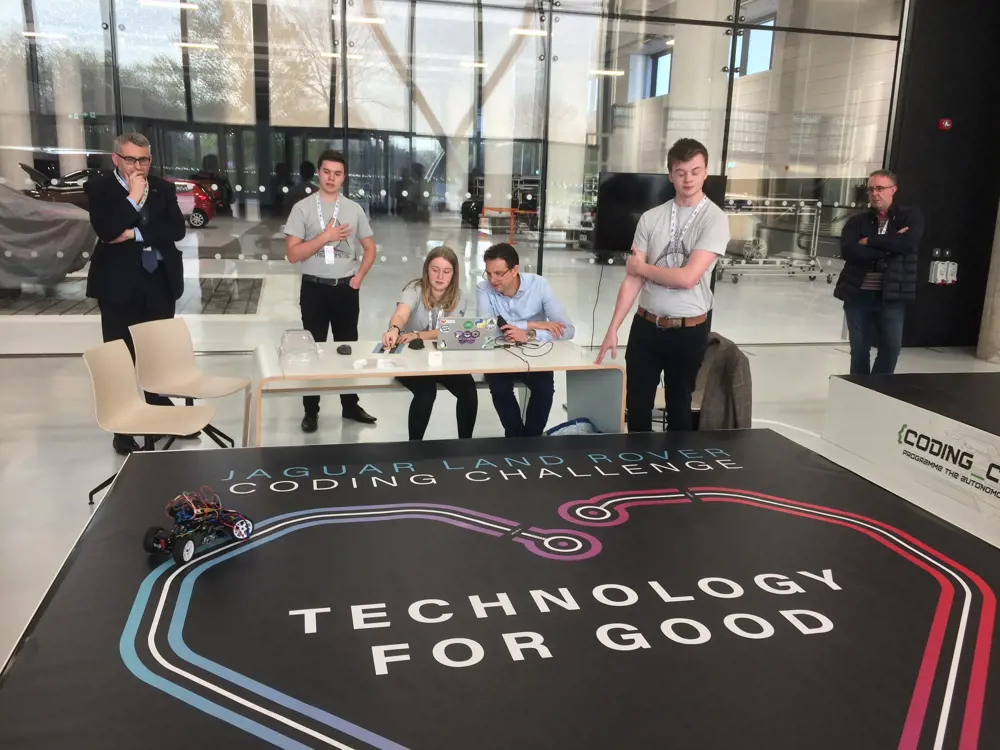
Rogers at the Land Rover 4x4 in Schools Technology Challenge, an annual competition led by Jaguar Land Rover to inspire, inform and develop the next generation of engineers © Jaguar Land Rover
Engineers of the future
Rogers shies away from talking about himself and turns the interview into a seminar on engineering with a handful of JLR’s recent graduates and apprentices, “the kids”, as he affectionately calls them. “I’m not supposed to call them that,” he admits to nods of agreement, and then goes on to explain that their role is to challenge him. “They are well behaved,” he adds, “but they are very capable of questioning anything.”
There is an important message behind Rogers’s plan: to him the graduates and apprentices are an essential part of his approach to overseeing engineering at JLR. It is about staying grounded in the engineering and always challenging yourself. Rogers constantly returns to the role of apprentices as he describes his moves to embed engineering, and the science behind it, much more deeply into the mindset at JLR. Walking around rooms full of engineers at workstations, Rogers points to one end where apprentices work together. “If I ever have a bad moment,” he says, “I go and sit with them for a half an hour and they cheer me up.”
Rogers was not able to study for A levels and then for a degree, so his career started not far from the bottom of the ladder
Most of today’s intake of apprentices are studying for engineering degrees. Rogers was not able to study for A levels and then for a degree, so his career started not far from the bottom of the ladder. His traditional technical apprenticeship involved learning how to do just about everything in a mechanical workshop, for example making his own steam engine. Since then, Rogers has held various engineering roles, starting in body engineering, where he worked on the Mini Convertible and the Rover 200, fitting in the time needed to get his technical engineering degree. He ended up as head of Rover Group’s body structure design team.
Engineering evolution throughout Roger's career
The UK’s car industry was going through interesting times throughout much of Rogers’s earlier career. The brands that came to be JLR went through several owners, including Ford and BMW, so Rogers has seen different approaches to engineering leadership. In 2008, everything began to change when Tata Motors acquired JLR and the two brands finally came together.
JLR’s current engineering time and effort is split equally between mechanical, electronic and electrical engineering. Of course, the complexity of electrical and electronic systems has increased over time so engineering time needs to be spent more efficiently. He brings up a chart showing that mechanical engineering consumes less engineering time than it used to. This does not mean, Rogers adds quickly, that mechanical engineering is less important, but moving into electric vehicles brings new challenges, not least being the management of batteries and electric motors. Today’s automotive engineers have to bring together a constantly changing raft of technologies.
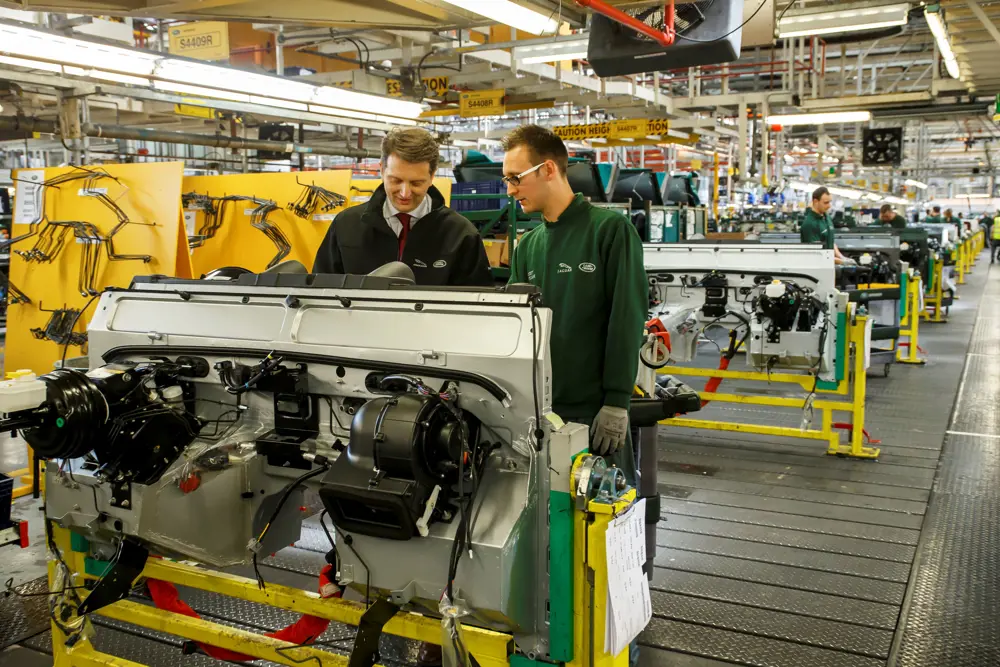
Rogers is a passionate advocate of staying grounded in practical engineering. This image was taken in 2015 on the production line of the two millionth Defender at Land Rover’s manufacturing facility in Solihull © Jaguar Land Rover
“When we started the journey four years ago, one of the key things that we were looking at was how did we put engineering back into the centre of what everybody did every day,” Rogers explains. As a part of his plans to maintain the technical skills of JLR’s engineers, Rogers has put in place what he describes as “a plan to get back to basic engineering”. In part, this was a response to the rapid growth of recent years. Ten years ago, JLR employed just 2,000 engineers. “When you grow quickly, you have to learn continuously and it is so important to remember the basics,” he explains. Now, JLR has created its own set of internal training modules following an analysis of industry changes, as well as relevant scientific theory and practical automotive applications that all JLR engineers need to know about. Rogers says that these are a key part of JLR’s engineering transformation over the past three years: “They are the foundation of knowledge for our engineering product delivery and we have already witnessed improvements in our products as a result, such as in the handling and dynamics of the new Range Rover Evoque.”
When Rogers became head of product engineering in 2015, he increased the annual intake of apprentices. He didn’t like the idea that JLR took in just a handful of budding engineers each year, so encouraged his team to look at the skills and capabilities that JLR would need to meet its future needs. In particular, he wanted them to find technically curious, highly skilled and efficient engineers.
Flexible, modular architecture to create the best products
When Nick Rogers first suggested that JLR should develop different car models at the same time, the underlying idea was that engineers would build new cars using shared principles within a common architecture. Where possible, different models would share components put together in a common layout, but with the distinctive look and ‘feel’ that drivers expect when they sit behind the steering wheel of a Jaguar or Land Rover.
“We are very passionate that the driving experience and capabilities of our cars all fit into the brands,” says Rogers. He thought that a common architecture could accommodate the variations needed to create cars that made the most of JLR’s engineering expertise, especially its intellectual property.
An important catalyst for the new approach was JLR’s promise that from 2020 all new models will offer a choice of ‘drive trains’, the part of a car that delivers power to the wheels. JLR’s showrooms would offer three systems: the traditional internal combustion engine paired with the mild hybrid electric vehicle, the plug-in hybrid electric vehicle or battery electric vehicle.
The underpinning framework that will enable this efficient, concurrent engineering is in what Rogers describes as associative vehicle architecture (AVA), JLR’s approach to digital engineering that is based in computer-aided design (CAD) and computer-aided engineering (CAE). “It is really about embedding our engineering knowledge base into our CAD and CAE tools and beyond,” says Keith Rose, CAD and AVA Senior Manager.
The AVA system is a growing set of computer models of the different parts and subsystems in a car that “embeds the science as algorithms and parameter values based on our engineering strategy for that part or system,” says Rose. “The vision is that the AVA is the live culmination of all the engineering knowledge that you have got,” adds Rogers. “That is why it is so powerful. You continuously build and add to the previous strategy, or best-so-far knowledge, rather than reinventing it every time you start a new product, encouraging engineers to formally integrate the learning from last time.”
The approach with AVA enables JLR to create results that may have previously taken days in hours, enabling the engineers to maximise their time on the most important part – using every minute to create the very best products possible for its customers.
Rogers’s pursuit of science does not stop at engineering. With human factors becoming increasingly important, he has recruited psychologists to work on such topics as car sickness. “I get dreadfully travel sick, so it is definitely a personal obsession. We are doing a lot of work, looking at cognitive load and the things that actually drive motion sickness.” After all, you don’t want to sell cars that make people feel queasy.
It is just an engineer’s way of thinking. “If somebody says something can’t be done, to most engineers that just provokes them into proving that it can be.”
Rogers’s interest in experiments doesn’t stop with cars and their drivers. Ever the hands-on engineer, he has investigated alternative uses for some of the engineering that goes into JLR’s electric cars. Rogers encouraged Stephen Boulter, Vehicle Engineering Manager for the I-PACE electric Jaguar, to take the car’s batteries and match them to an integrated starter generator from one of JLR’s hybrid vehicles. Run it in one direction and it generates electricity, reverse it and you have a generator, Rogers explains. Add some three-metre turbine blades and you get a three-kilowatt wind turbine.
As Rogers explains it, he was thinking of putting solar panels on the roof of his house “but if you look at the return you are much better putting up a wind turbine than you are solar panels”. But Boulter gives the game away when he adds: “We are doing it for bit of fun aren’t we?”. Sure, says Rogers, but for him it all comes back to engineering, trying to spend time with the teams, being practical, thinking through ideas. Rogers admits that he is “obsessed about being curious”. It is just an engineer’s way of thinking. “If somebody says something can’t be done, to most engineers that just provokes them into proving that it can be.”
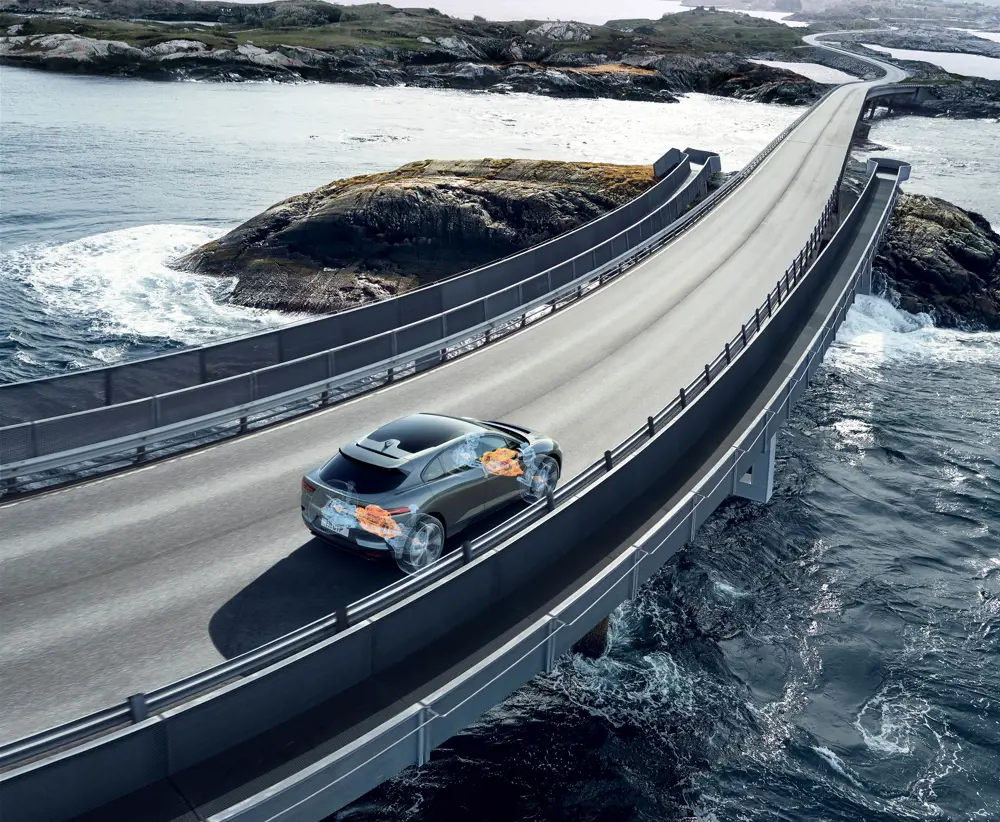
The Jaguar I-Pace is JLR’s first all-electric vehicle © Jaguar Land Rover
Electric transformation
A driving force behind the need for technically curious engineers is the rapid pace of change in the car industry. He says of his own time in the industry: “I think that the only constant has been building cars.” Electric cars are increasingly popular and there is much talk of autonomous vehicles, a concept that already influences car designers and engineers. An immediate issue for JLR’s engineers is managing batteries in electric cars. As a testbed for its own technology, JLR has one of the biggest arrays of electric charging stations in the UK.
The company’s engineers also work with its Formula-E Jaguar Racing team. “We are using that as a testbed to prove technology. Batteries are incredibly expensive, so the battery management system is one of the most valuable commodities in the battery electric car. Any fraction of efficiency that you can get from optimising the energy going in and out of the battery is key intellectual property.”
Another hot area of automotive engineering is in the ‘infotainment’ system. On a guided tour of JLR’s facilities, Rogers points to a benchtop rig where engineers are testing hardware and software for future generations of such systems. The whole integration process of JLR’s infotainment system was, Rogers says, “the biggest learning experience I have ever had in my life.” The electronic side of cars is now so important that at the beginning of 2018 JLR set up its own Software Engineering Centre in Shannon, Ireland. Around 150 people work on new technologies to support electrification and self-driving features on future Jaguar and Land Rover vehicles.
Rogers says that the infotainment system has always been an example of the car’s human–machine interface. In electric cars, the system brings together battery management and navigation. “When you plot a route, it knows when you’re going to go uphill and downhill, making sure that you manage the energy within the battery to maximise so that every time you’re going downhill you can regenerate as much energy as possible to then go back uphill. So it is actually planning the energy usage over your journey.”
The Shannon team has also recently launched ‘smart wallet’ technology that lets drivers earn cryptocurrency for sharing information about traffic jams and potholes, which is used to automatically pay for tolls, parking and electric charging
Career timeline and distinctions
Born, 1967. Apprentice Technician, British Leyland/Rover Group, 1984–1988. Gained a degree in mechanical engineering from Coventry University, 1993. Chief Engineer, Rover Body Structures Design, 1995–1998. Chief Programme Engineer, Land Rover 2003–2005. Lean Manufacturing Manager, Land Rover, 2005–2007. Director of Global Architecture, Jaguar Land Rover, 2007–2015. Executive Director, Product Engineering, 2015–2022. Non-Executive Director and Executive Advisor, Rogers Advisory, 2023–present. Fellow of the Royal Academy of Engineering, 2018.
A feature that appeals to JLR’s engineers is the ability to harvest data from various systems in the car, including infotainment, to understand vehicle usage. “This is really cool,” says Rogers, “the engineers are actually using data from the car, to find out how people really use their vehicles.” With its own fleet of electric vehicles, JLR has a growing flow of data from around 4,000 cars. “If there were software bugs, we might be able to proactively identify them before the customer sees them and find ways of fixing them.”
The Shannon team has also recently launched ‘smart wallet’ technology that lets drivers earn cryptocurrency for sharing information about traffic jams and potholes, which is used to automatically pay for tolls, parking and electric charging. The data sharing service is optional and anonymous. Customers can opt in via their infotainment system and anonymously share data such as road surface conditions, without linking it back to their specific car.
Few areas of automotive engineering have been immune to the accelerating pace of technological change. Diesel engines, for example, went from hero to villain in what seems like the blink of an eye when other engine makers were caught cheating the testing regime for emissions. By good fortune, this happened around the time that JLR set up a production line to manufacture its own range of diesels – a facility that was nominated for the Royal Academy of Engineering’s MacRobert Award in 2015. “Engineering our own flexible engine architecture enables us to meet our bespoke needs, allowing JLR to adapt and stay ahead of changes in regulation and technology,” Rogers says.
Rogers now has to plan for a world that may remove diesel engines completely. “If you look at the clean diesels that we make now, the level of nitrogen oxides (NOx) is hundreds of times less than it was a few years ago,” he says. JLR’s new engines already deliver the level of admissions and NOx reductions of 2020 regulations and have delivered a 90% reduction in NOx emissions since 2010. He then digs out a diagram of a diesel engine displaying exhaust technology that shows the “very efficient chemistry that we have inside the car”. As Rogers sees it, ditching diesel engines does not make sense. “The engineering facts … are that every government across the globe that cares about health should be encouraging new, cleaner diesels.”
The truth is that you have to have the courage to do the whole lot at once
The need to respond to political pressure has also done much to drive the development of electric vehicles. The need to do this while simultaneously developing new models with internal combustion engines has fuelled a revolution in how JLR’s engineers develop new car models. Instead of working on new models sequentially, Rogers persuaded JLR that it should work on several models at the same time, while using a new computerised approach to engineering. The response he got was “how can you do that?”. As he saw it, this was the only way in which JLR could achieve its ambitions for delivering a series of new Land Rovers and Jaguars. “The truth is that you have to have the courage to do the whole lot at once,” Rogers insists.
***
Since this article was published, Nick Rogers FREng has become the Non-Executive Director and Executive Advisor of Rogers Advisory, which provides expertise and guidance to global enterprises.
This article has been adapted from "Driven to a electrifying future", which originally appeared in the print edition of Ingenia 79 (June 2019).
Contributors
Michael Kenward OBE
Author
Keep up-to-date with Ingenia for free
SubscribeRelated content
Electricals & electronics

Accelerometers
Used in earthquake measurements, laptops, planes and even in stargazing apps, today’s accelerometers are much smaller than when they were first developed in 1927. Find out how they detect movement and vibration.

How to maximise loudspeaker quality
Ingenia asked Dr Jack Oclee-Brown, Head of Acoustics at KEF Audio, to outline the considerations that audio engineers need to make when developing high-quality speakers.

Cable fault locator
The winner of the Institute of Engineering and Technology’s 2014 Innovation Award was EA Technology’s CableSnifferTM, which uses a probe and chemical sensing technology to identify faults, saving energy companies millions of pounds each year.
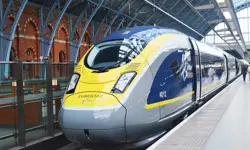
High speed evolution
In December 2010, Eurostar International Ltd awarded a contract for 10 new high speed trains to Siemens. The company has used a system developed over decades to maximise the performance and passenger-carrying ability of its 320km/h trains.
Other content from Ingenia
Quick read

- Environment & sustainability
- Opinion
A young engineer’s perspective on the good, the bad and the ugly of COP27

- Environment & sustainability
- Issue 95
How do we pay for net zero technologies?
Quick read

- Transport
- Mechanical
- How I got here
Electrifying trains and STEMAZING outreach

- Civil & structural
- Environment & sustainability
- Issue 95